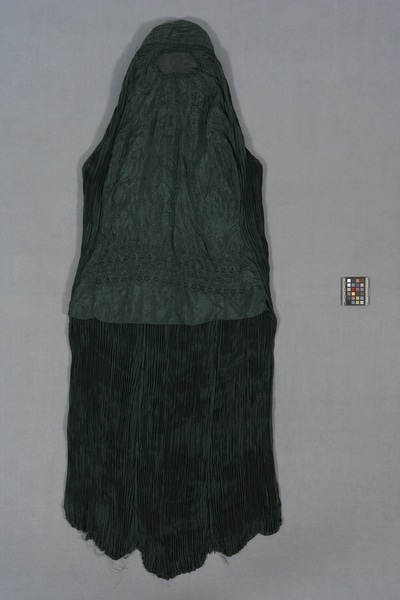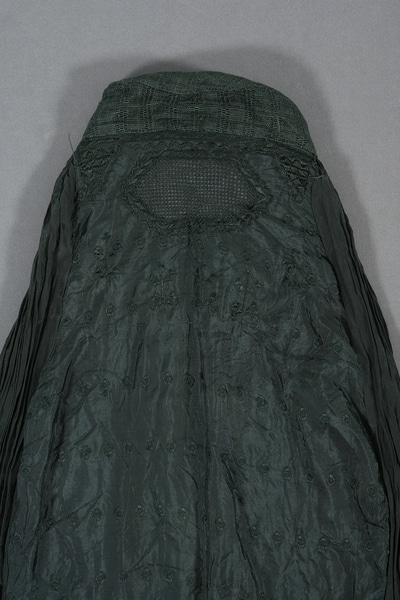Garment Item Number: 811/7 from the MOA: University of British Columbia


Description
Woman’s burqa, a long, flowing, overall body covering. The garment envelops the entire body, head to feet, and consists of a pillbox headpiece, a mesh facepiece and a full sack-like covering, embellished with embroidery and fine pleating. Extends to the hips in front and to the feet in the back. The mesh facepiece is worked in counted-thread openwork embroidery. An embroidered panel that extends to the hip area in the front is finely stitched with floral and geometric motifs. The back is finely pleated and is a darker green than the front. Two shades of dark green, with dark green embroidery.
History Of Use
A burqa, or other types of face-covering veil, was part of a traditional Pashtun costume, which consisted of dress, pants, shoes and veil, but this costume started to go out of style in the 1930s. In some, but not all, Muslim communities in Afghanistan wearing the chadri is required of women when they go out into public places, according to custom and the dictates of local authorities. The Pastun nomads, a group who travel back and forth across the Pakistan/Afghan border on their annual migration, have been severely affected by war and political strife in recent years, and many now live in settlements.
Narrative
Collected by Allice Legat in Afghanistan in 1977, while she was doing field work there.
Iconographic Meaning
Wearing of the chadri symbolizes satr, or seclusion, and purdah, or dignity, signifying hospitality, honesty, caring for relatives and dressing properly. A part of the “honor and shame complex in the area, relating to concepts of correct conduct, especially the sexual conduct of women which is seen to reflect on the status of male relatives” (Legat).
Item History
- Made in Ghazni, Afghanistan during 1935
- Collected in Kabul, Afghanistan during 1977
- Owned by Allice Legat before June 21, 1982
- Received from Allice Legat (Seller) and Museum of Anthropology Shop Volunteers (Funding source) on June 21, 1982
What
- Name
- Garment
- Identification Number
- 811/7
- Type of Item
- garment
- Material
- dye, rayon fibre ?, silk fibre ? and cotton fibre
- Overall
- height 163.5 cm, width 88.0 cm
Who
- Culture
- Pashtun: Kuchi
- Previous Owner
- Allice Legat
- Received from
- Allice Legat (Seller) and Museum of Anthropology Shop Volunteers (Funding source)
Where
- Holding Institution
- MOA: University of British Columbia
- Made in
- Ghazni, Afghanistan
- Collected in
- Kabul, Afghanistan
When
- Creation Date
- during 1935
- Collection Date
- during 1977
- Ownership Date
- before June 21, 1982
- Acquisition Date
- on June 21, 1982
Other
- Item Classes
- textiles
- Condition
- good
- Accession Number
- 0811/0007